EIA's Role in Achieving Sustainable Development Goals in South Africa
VerifiedAdded on 2022/08/22
|21
|4690
|62
Report
AI Summary
This report evaluates the effectiveness of Environmental Impact Assessment (EIA) in South Africa in achieving the United Nations' Sustainable Development Goals (SDGs). It begins by introducing the concept of EIA as a tool for sustainable development and its international application, particularly in the context of the 2030 Agenda. The methodology section outlines the research philosophy of positivism and the descriptive/analytical research design employed to analyze the steps taken by South Africa to achieve the SDGs, including data collection from primary and secondary sources. The results section presents a table summarizing the gaps in SDG attainment across various goals, such as poverty reduction, food security, healthcare, education, gender equality, economic growth, infrastructure, inequality, sustainable consumption, and environmental protection. Additionally, the report discusses the role of legislation in South Africa towards the achievement of sustainable development. The report concludes with recommendations for improving EIA practices to better align with SDG objectives, emphasizing the need for comprehensive environmental management to ensure social equity, economic viability, and environmental sustainability. This report offers valuable insights for students and researchers studying environmental science and sustainable development, and is available on Desklib, a platform providing AI-based study tools.
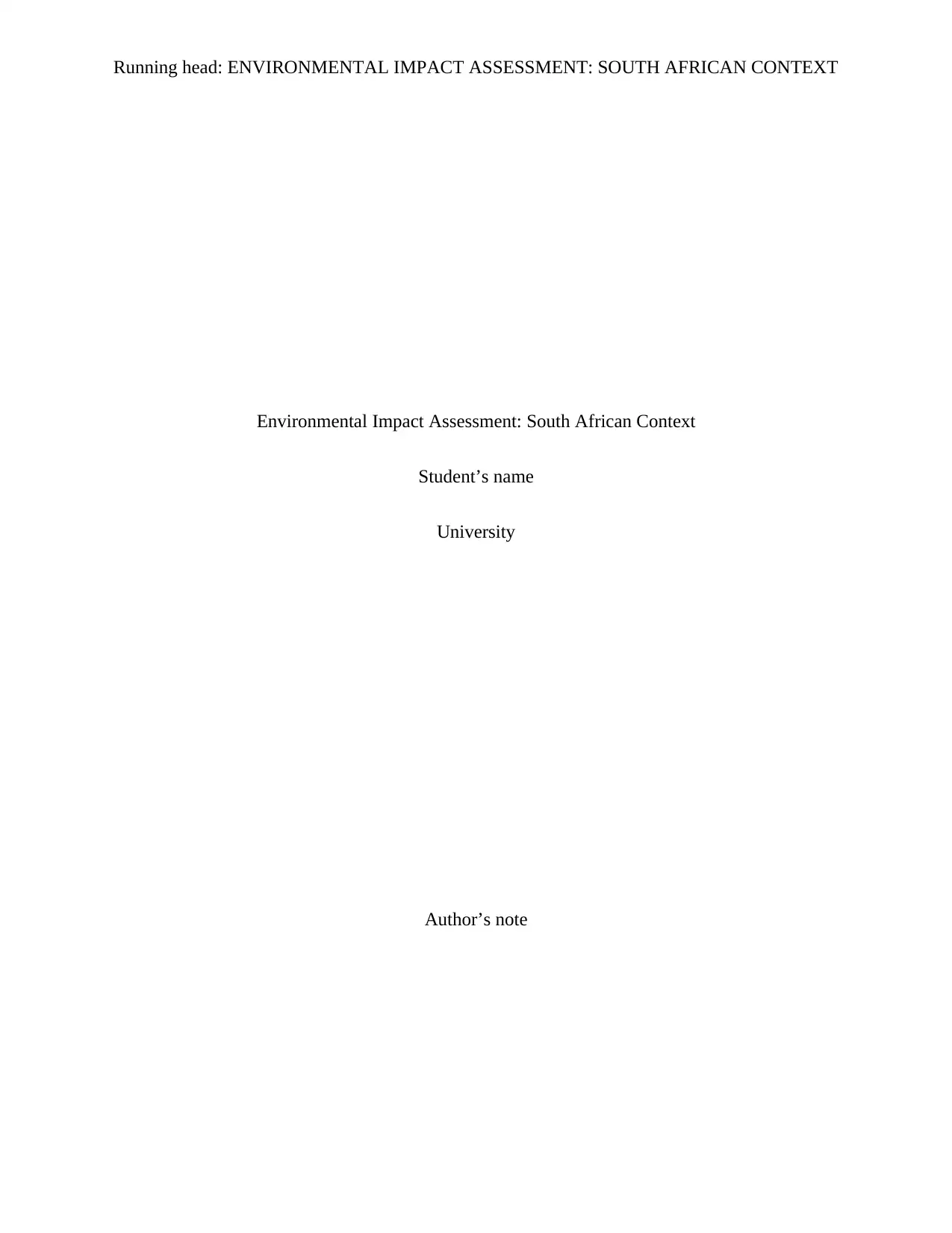
Running head: ENVIRONMENTAL IMPACT ASSESSMENT: SOUTH AFRICAN CONTEXT
Environmental Impact Assessment: South African Context
Student’s name
University
Author’s note
Environmental Impact Assessment: South African Context
Student’s name
University
Author’s note
Paraphrase This Document
Need a fresh take? Get an instant paraphrase of this document with our AI Paraphraser
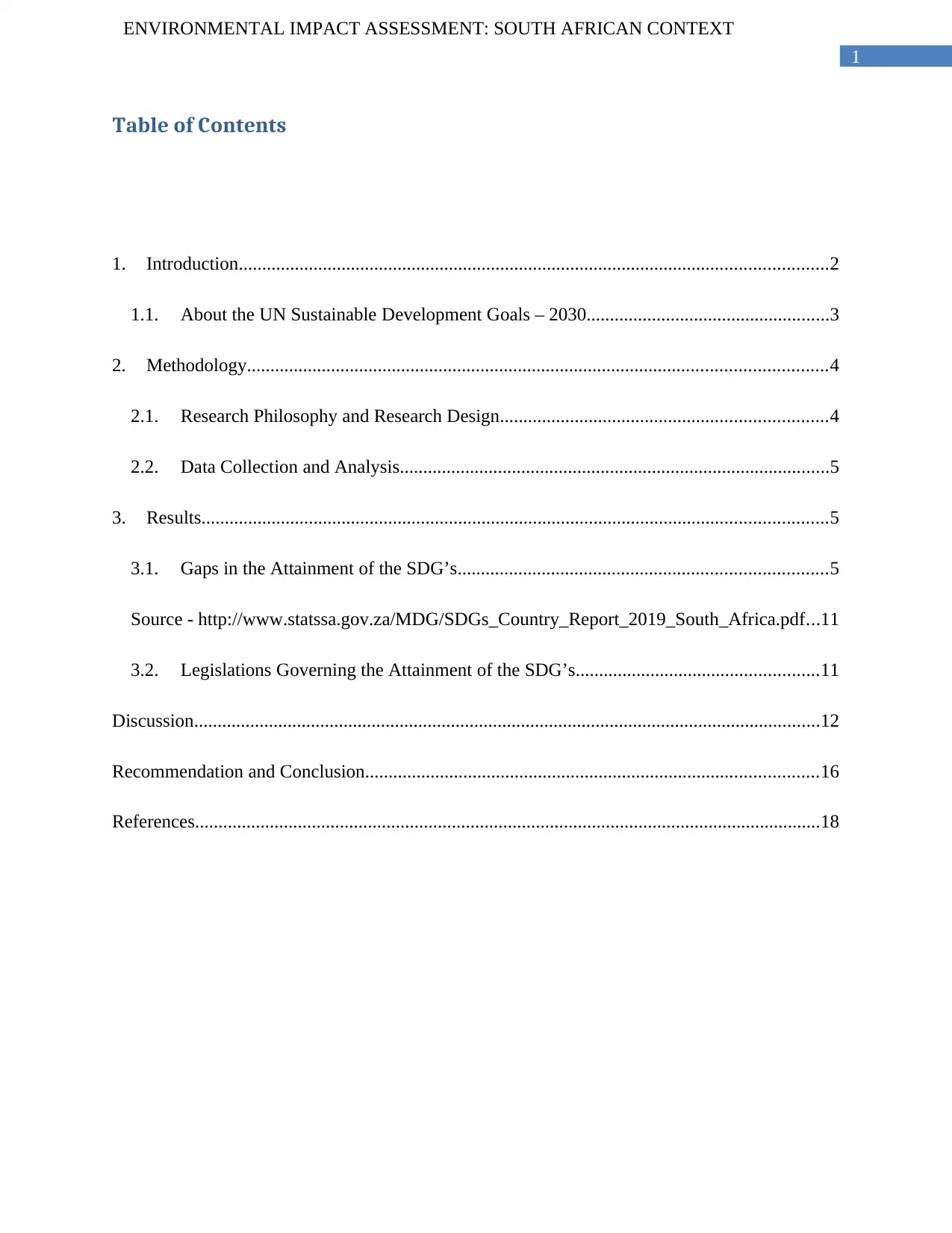
1
ENVIRONMENTAL IMPACT ASSESSMENT: SOUTH AFRICAN CONTEXT
Table of Contents
1. Introduction..............................................................................................................................2
1.1. About the UN Sustainable Development Goals – 2030....................................................3
2. Methodology............................................................................................................................4
2.1. Research Philosophy and Research Design......................................................................4
2.2. Data Collection and Analysis............................................................................................5
3. Results......................................................................................................................................5
3.1. Gaps in the Attainment of the SDG’s...............................................................................5
Source - http://www.statssa.gov.za/MDG/SDGs_Country_Report_2019_South_Africa.pdf...11
3.2. Legislations Governing the Attainment of the SDG’s....................................................11
Discussion......................................................................................................................................12
Recommendation and Conclusion.................................................................................................16
References......................................................................................................................................18
ENVIRONMENTAL IMPACT ASSESSMENT: SOUTH AFRICAN CONTEXT
Table of Contents
1. Introduction..............................................................................................................................2
1.1. About the UN Sustainable Development Goals – 2030....................................................3
2. Methodology............................................................................................................................4
2.1. Research Philosophy and Research Design......................................................................4
2.2. Data Collection and Analysis............................................................................................5
3. Results......................................................................................................................................5
3.1. Gaps in the Attainment of the SDG’s...............................................................................5
Source - http://www.statssa.gov.za/MDG/SDGs_Country_Report_2019_South_Africa.pdf...11
3.2. Legislations Governing the Attainment of the SDG’s....................................................11
Discussion......................................................................................................................................12
Recommendation and Conclusion.................................................................................................16
References......................................................................................................................................18
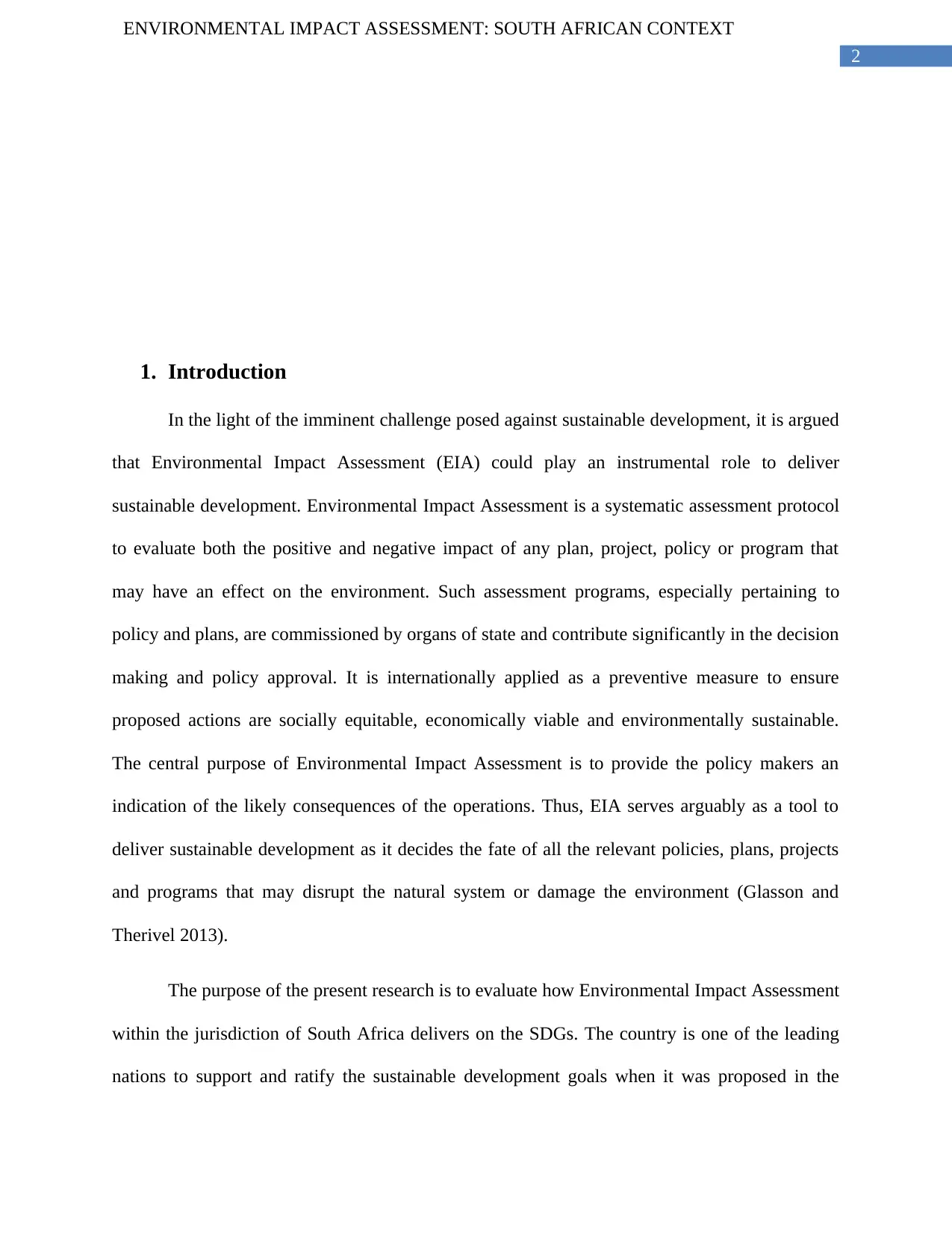
2
ENVIRONMENTAL IMPACT ASSESSMENT: SOUTH AFRICAN CONTEXT
1. Introduction
In the light of the imminent challenge posed against sustainable development, it is argued
that Environmental Impact Assessment (EIA) could play an instrumental role to deliver
sustainable development. Environmental Impact Assessment is a systematic assessment protocol
to evaluate both the positive and negative impact of any plan, project, policy or program that
may have an effect on the environment. Such assessment programs, especially pertaining to
policy and plans, are commissioned by organs of state and contribute significantly in the decision
making and policy approval. It is internationally applied as a preventive measure to ensure
proposed actions are socially equitable, economically viable and environmentally sustainable.
The central purpose of Environmental Impact Assessment is to provide the policy makers an
indication of the likely consequences of the operations. Thus, EIA serves arguably as a tool to
deliver sustainable development as it decides the fate of all the relevant policies, plans, projects
and programs that may disrupt the natural system or damage the environment (Glasson and
Therivel 2013).
The purpose of the present research is to evaluate how Environmental Impact Assessment
within the jurisdiction of South Africa delivers on the SDGs. The country is one of the leading
nations to support and ratify the sustainable development goals when it was proposed in the
ENVIRONMENTAL IMPACT ASSESSMENT: SOUTH AFRICAN CONTEXT
1. Introduction
In the light of the imminent challenge posed against sustainable development, it is argued
that Environmental Impact Assessment (EIA) could play an instrumental role to deliver
sustainable development. Environmental Impact Assessment is a systematic assessment protocol
to evaluate both the positive and negative impact of any plan, project, policy or program that
may have an effect on the environment. Such assessment programs, especially pertaining to
policy and plans, are commissioned by organs of state and contribute significantly in the decision
making and policy approval. It is internationally applied as a preventive measure to ensure
proposed actions are socially equitable, economically viable and environmentally sustainable.
The central purpose of Environmental Impact Assessment is to provide the policy makers an
indication of the likely consequences of the operations. Thus, EIA serves arguably as a tool to
deliver sustainable development as it decides the fate of all the relevant policies, plans, projects
and programs that may disrupt the natural system or damage the environment (Glasson and
Therivel 2013).
The purpose of the present research is to evaluate how Environmental Impact Assessment
within the jurisdiction of South Africa delivers on the SDGs. The country is one of the leading
nations to support and ratify the sustainable development goals when it was proposed in the
⊘ This is a preview!⊘
Do you want full access?
Subscribe today to unlock all pages.

Trusted by 1+ million students worldwide
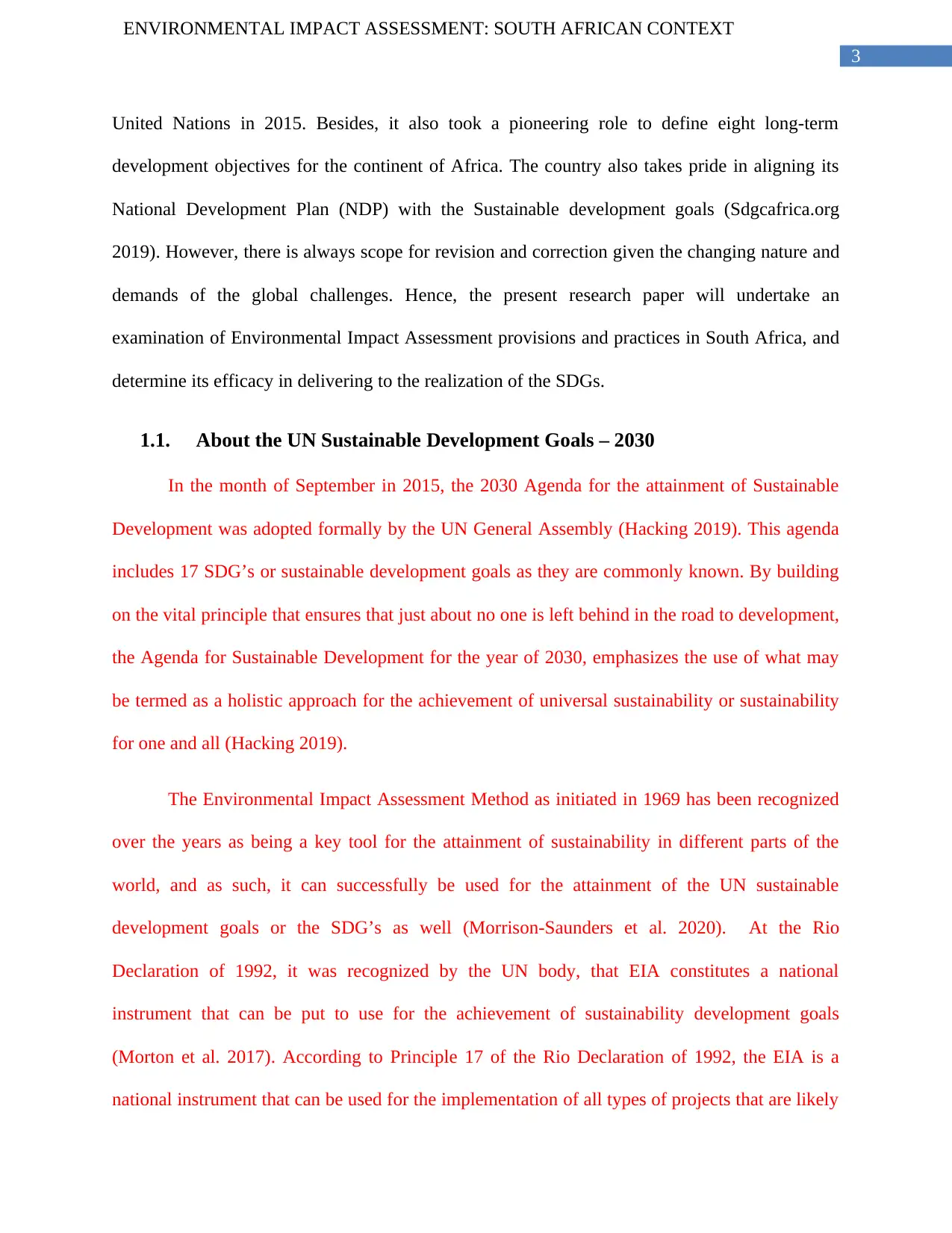
3
ENVIRONMENTAL IMPACT ASSESSMENT: SOUTH AFRICAN CONTEXT
United Nations in 2015. Besides, it also took a pioneering role to define eight long-term
development objectives for the continent of Africa. The country also takes pride in aligning its
National Development Plan (NDP) with the Sustainable development goals (Sdgcafrica.org
2019). However, there is always scope for revision and correction given the changing nature and
demands of the global challenges. Hence, the present research paper will undertake an
examination of Environmental Impact Assessment provisions and practices in South Africa, and
determine its efficacy in delivering to the realization of the SDGs.
1.1. About the UN Sustainable Development Goals – 2030
In the month of September in 2015, the 2030 Agenda for the attainment of Sustainable
Development was adopted formally by the UN General Assembly (Hacking 2019). This agenda
includes 17 SDG’s or sustainable development goals as they are commonly known. By building
on the vital principle that ensures that just about no one is left behind in the road to development,
the Agenda for Sustainable Development for the year of 2030, emphasizes the use of what may
be termed as a holistic approach for the achievement of universal sustainability or sustainability
for one and all (Hacking 2019).
The Environmental Impact Assessment Method as initiated in 1969 has been recognized
over the years as being a key tool for the attainment of sustainability in different parts of the
world, and as such, it can successfully be used for the attainment of the UN sustainable
development goals or the SDG’s as well (Morrison-Saunders et al. 2020). At the Rio
Declaration of 1992, it was recognized by the UN body, that EIA constitutes a national
instrument that can be put to use for the achievement of sustainability development goals
(Morton et al. 2017). According to Principle 17 of the Rio Declaration of 1992, the EIA is a
national instrument that can be used for the implementation of all types of projects that are likely
ENVIRONMENTAL IMPACT ASSESSMENT: SOUTH AFRICAN CONTEXT
United Nations in 2015. Besides, it also took a pioneering role to define eight long-term
development objectives for the continent of Africa. The country also takes pride in aligning its
National Development Plan (NDP) with the Sustainable development goals (Sdgcafrica.org
2019). However, there is always scope for revision and correction given the changing nature and
demands of the global challenges. Hence, the present research paper will undertake an
examination of Environmental Impact Assessment provisions and practices in South Africa, and
determine its efficacy in delivering to the realization of the SDGs.
1.1. About the UN Sustainable Development Goals – 2030
In the month of September in 2015, the 2030 Agenda for the attainment of Sustainable
Development was adopted formally by the UN General Assembly (Hacking 2019). This agenda
includes 17 SDG’s or sustainable development goals as they are commonly known. By building
on the vital principle that ensures that just about no one is left behind in the road to development,
the Agenda for Sustainable Development for the year of 2030, emphasizes the use of what may
be termed as a holistic approach for the achievement of universal sustainability or sustainability
for one and all (Hacking 2019).
The Environmental Impact Assessment Method as initiated in 1969 has been recognized
over the years as being a key tool for the attainment of sustainability in different parts of the
world, and as such, it can successfully be used for the attainment of the UN sustainable
development goals or the SDG’s as well (Morrison-Saunders et al. 2020). At the Rio
Declaration of 1992, it was recognized by the UN body, that EIA constitutes a national
instrument that can be put to use for the achievement of sustainability development goals
(Morton et al. 2017). According to Principle 17 of the Rio Declaration of 1992, the EIA is a
national instrument that can be used for the implementation of all types of projects that are likely
Paraphrase This Document
Need a fresh take? Get an instant paraphrase of this document with our AI Paraphraser
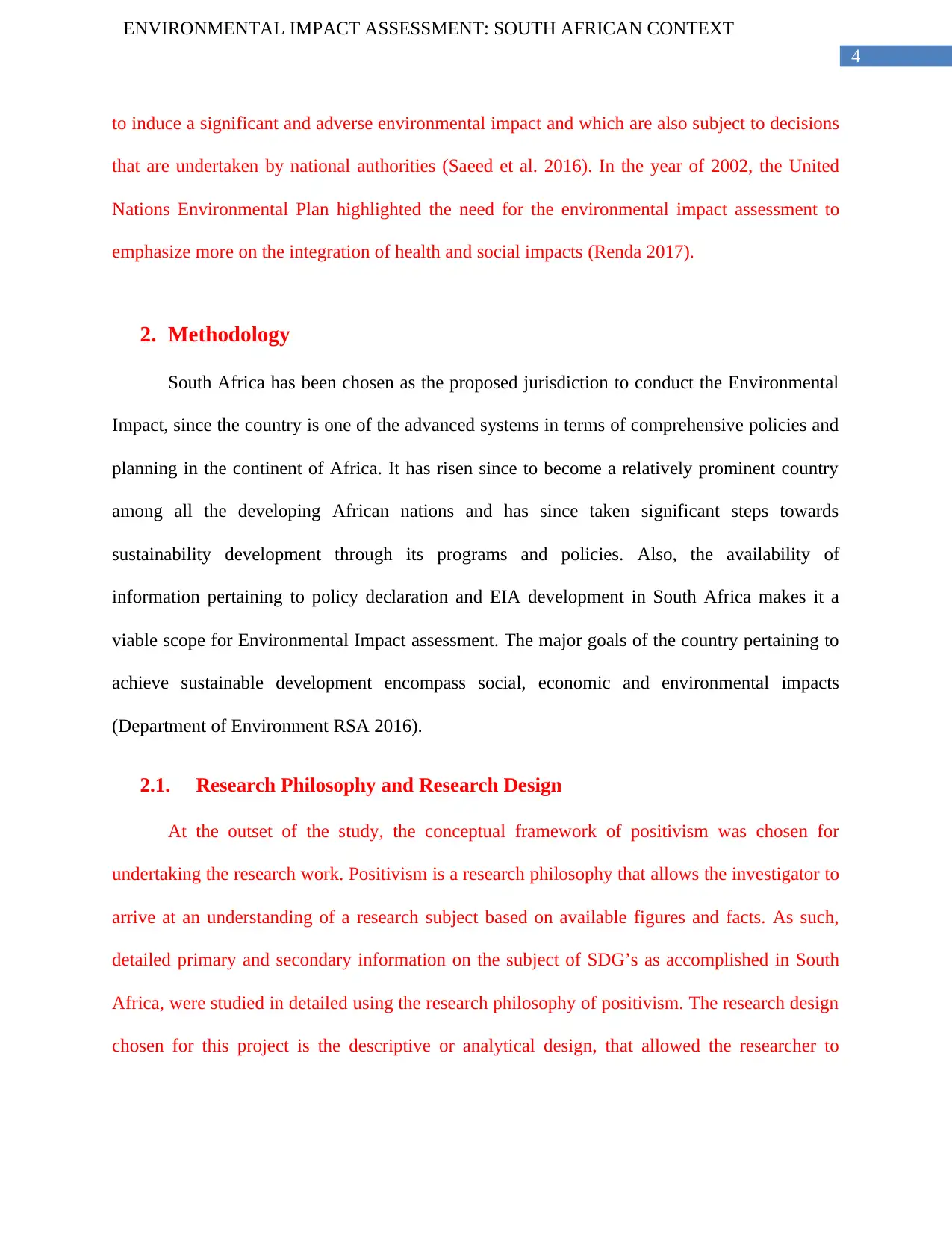
4
ENVIRONMENTAL IMPACT ASSESSMENT: SOUTH AFRICAN CONTEXT
to induce a significant and adverse environmental impact and which are also subject to decisions
that are undertaken by national authorities (Saeed et al. 2016). In the year of 2002, the United
Nations Environmental Plan highlighted the need for the environmental impact assessment to
emphasize more on the integration of health and social impacts (Renda 2017).
2. Methodology
South Africa has been chosen as the proposed jurisdiction to conduct the Environmental
Impact, since the country is one of the advanced systems in terms of comprehensive policies and
planning in the continent of Africa. It has risen since to become a relatively prominent country
among all the developing African nations and has since taken significant steps towards
sustainability development through its programs and policies. Also, the availability of
information pertaining to policy declaration and EIA development in South Africa makes it a
viable scope for Environmental Impact assessment. The major goals of the country pertaining to
achieve sustainable development encompass social, economic and environmental impacts
(Department of Environment RSA 2016).
2.1. Research Philosophy and Research Design
At the outset of the study, the conceptual framework of positivism was chosen for
undertaking the research work. Positivism is a research philosophy that allows the investigator to
arrive at an understanding of a research subject based on available figures and facts. As such,
detailed primary and secondary information on the subject of SDG’s as accomplished in South
Africa, were studied in detailed using the research philosophy of positivism. The research design
chosen for this project is the descriptive or analytical design, that allowed the researcher to
ENVIRONMENTAL IMPACT ASSESSMENT: SOUTH AFRICAN CONTEXT
to induce a significant and adverse environmental impact and which are also subject to decisions
that are undertaken by national authorities (Saeed et al. 2016). In the year of 2002, the United
Nations Environmental Plan highlighted the need for the environmental impact assessment to
emphasize more on the integration of health and social impacts (Renda 2017).
2. Methodology
South Africa has been chosen as the proposed jurisdiction to conduct the Environmental
Impact, since the country is one of the advanced systems in terms of comprehensive policies and
planning in the continent of Africa. It has risen since to become a relatively prominent country
among all the developing African nations and has since taken significant steps towards
sustainability development through its programs and policies. Also, the availability of
information pertaining to policy declaration and EIA development in South Africa makes it a
viable scope for Environmental Impact assessment. The major goals of the country pertaining to
achieve sustainable development encompass social, economic and environmental impacts
(Department of Environment RSA 2016).
2.1. Research Philosophy and Research Design
At the outset of the study, the conceptual framework of positivism was chosen for
undertaking the research work. Positivism is a research philosophy that allows the investigator to
arrive at an understanding of a research subject based on available figures and facts. As such,
detailed primary and secondary information on the subject of SDG’s as accomplished in South
Africa, were studied in detailed using the research philosophy of positivism. The research design
chosen for this project is the descriptive or analytical design, that allowed the researcher to
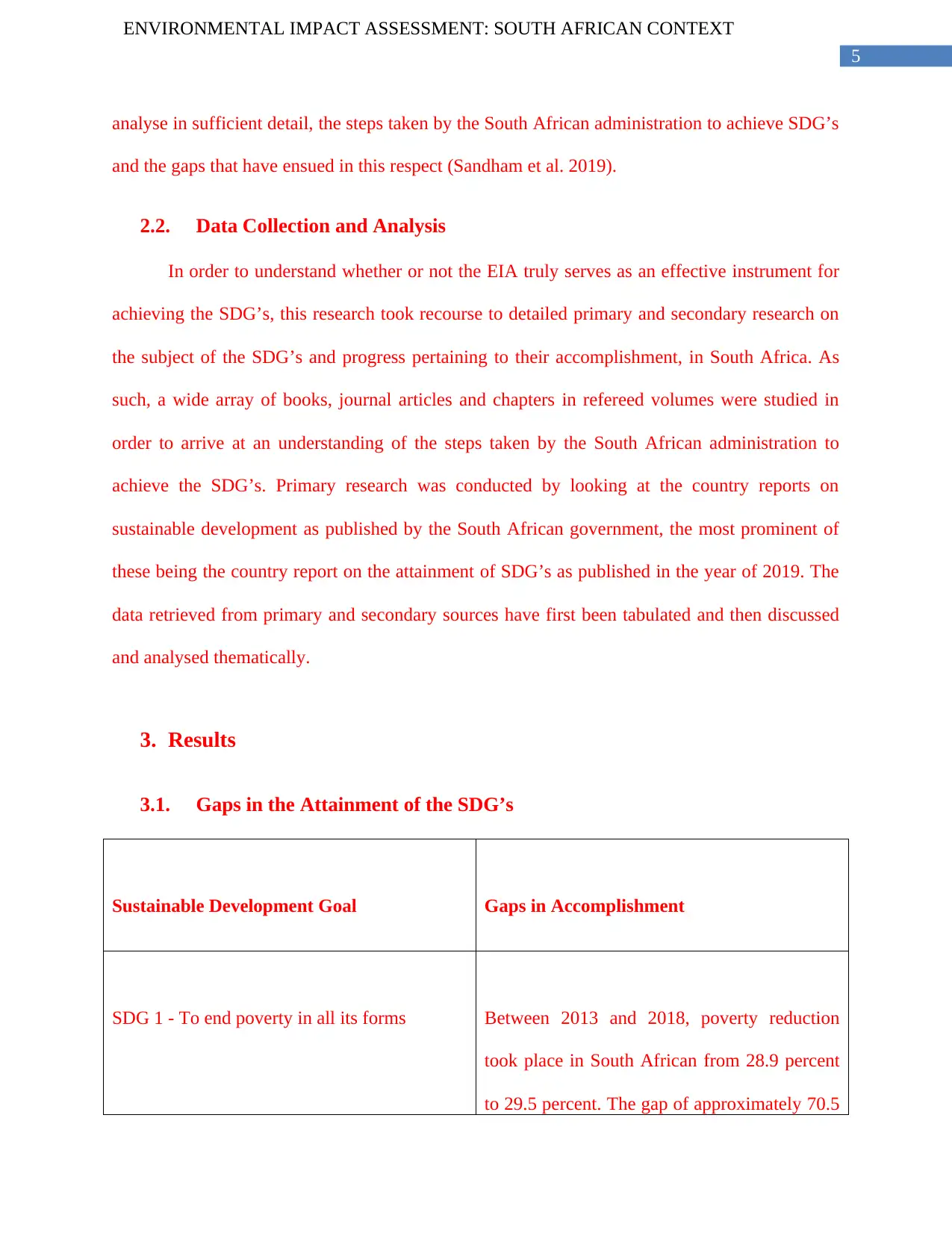
5
ENVIRONMENTAL IMPACT ASSESSMENT: SOUTH AFRICAN CONTEXT
analyse in sufficient detail, the steps taken by the South African administration to achieve SDG’s
and the gaps that have ensued in this respect (Sandham et al. 2019).
2.2. Data Collection and Analysis
In order to understand whether or not the EIA truly serves as an effective instrument for
achieving the SDG’s, this research took recourse to detailed primary and secondary research on
the subject of the SDG’s and progress pertaining to their accomplishment, in South Africa. As
such, a wide array of books, journal articles and chapters in refereed volumes were studied in
order to arrive at an understanding of the steps taken by the South African administration to
achieve the SDG’s. Primary research was conducted by looking at the country reports on
sustainable development as published by the South African government, the most prominent of
these being the country report on the attainment of SDG’s as published in the year of 2019. The
data retrieved from primary and secondary sources have first been tabulated and then discussed
and analysed thematically.
3. Results
3.1. Gaps in the Attainment of the SDG’s
Sustainable Development Goal Gaps in Accomplishment
SDG 1 - To end poverty in all its forms Between 2013 and 2018, poverty reduction
took place in South African from 28.9 percent
to 29.5 percent. The gap of approximately 70.5
ENVIRONMENTAL IMPACT ASSESSMENT: SOUTH AFRICAN CONTEXT
analyse in sufficient detail, the steps taken by the South African administration to achieve SDG’s
and the gaps that have ensued in this respect (Sandham et al. 2019).
2.2. Data Collection and Analysis
In order to understand whether or not the EIA truly serves as an effective instrument for
achieving the SDG’s, this research took recourse to detailed primary and secondary research on
the subject of the SDG’s and progress pertaining to their accomplishment, in South Africa. As
such, a wide array of books, journal articles and chapters in refereed volumes were studied in
order to arrive at an understanding of the steps taken by the South African administration to
achieve the SDG’s. Primary research was conducted by looking at the country reports on
sustainable development as published by the South African government, the most prominent of
these being the country report on the attainment of SDG’s as published in the year of 2019. The
data retrieved from primary and secondary sources have first been tabulated and then discussed
and analysed thematically.
3. Results
3.1. Gaps in the Attainment of the SDG’s
Sustainable Development Goal Gaps in Accomplishment
SDG 1 - To end poverty in all its forms Between 2013 and 2018, poverty reduction
took place in South African from 28.9 percent
to 29.5 percent. The gap of approximately 70.5
⊘ This is a preview!⊘
Do you want full access?
Subscribe today to unlock all pages.

Trusted by 1+ million students worldwide
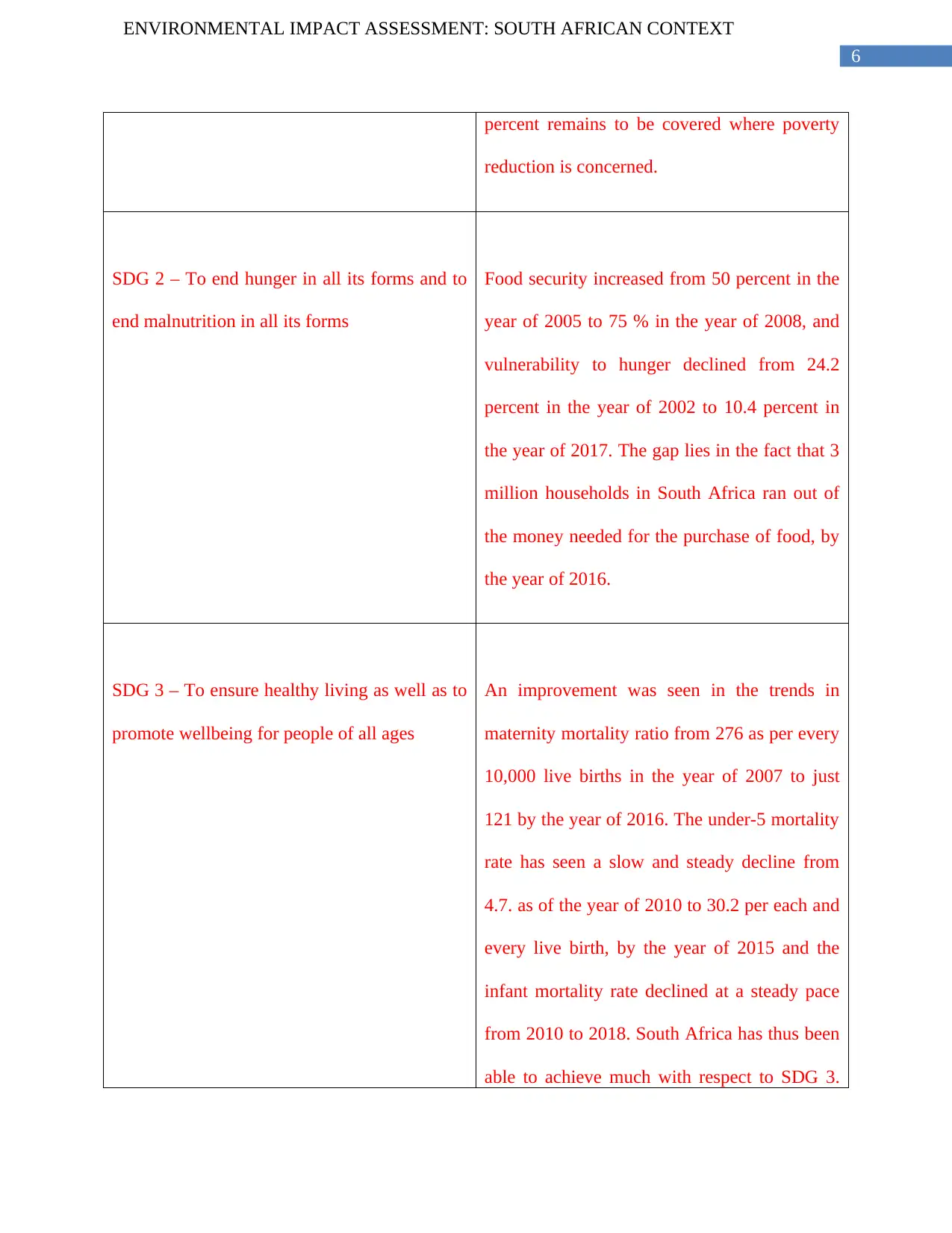
6
ENVIRONMENTAL IMPACT ASSESSMENT: SOUTH AFRICAN CONTEXT
percent remains to be covered where poverty
reduction is concerned.
SDG 2 – To end hunger in all its forms and to
end malnutrition in all its forms
Food security increased from 50 percent in the
year of 2005 to 75 % in the year of 2008, and
vulnerability to hunger declined from 24.2
percent in the year of 2002 to 10.4 percent in
the year of 2017. The gap lies in the fact that 3
million households in South Africa ran out of
the money needed for the purchase of food, by
the year of 2016.
SDG 3 – To ensure healthy living as well as to
promote wellbeing for people of all ages
An improvement was seen in the trends in
maternity mortality ratio from 276 as per every
10,000 live births in the year of 2007 to just
121 by the year of 2016. The under-5 mortality
rate has seen a slow and steady decline from
4.7. as of the year of 2010 to 30.2 per each and
every live birth, by the year of 2015 and the
infant mortality rate declined at a steady pace
from 2010 to 2018. South Africa has thus been
able to achieve much with respect to SDG 3.
ENVIRONMENTAL IMPACT ASSESSMENT: SOUTH AFRICAN CONTEXT
percent remains to be covered where poverty
reduction is concerned.
SDG 2 – To end hunger in all its forms and to
end malnutrition in all its forms
Food security increased from 50 percent in the
year of 2005 to 75 % in the year of 2008, and
vulnerability to hunger declined from 24.2
percent in the year of 2002 to 10.4 percent in
the year of 2017. The gap lies in the fact that 3
million households in South Africa ran out of
the money needed for the purchase of food, by
the year of 2016.
SDG 3 – To ensure healthy living as well as to
promote wellbeing for people of all ages
An improvement was seen in the trends in
maternity mortality ratio from 276 as per every
10,000 live births in the year of 2007 to just
121 by the year of 2016. The under-5 mortality
rate has seen a slow and steady decline from
4.7. as of the year of 2010 to 30.2 per each and
every live birth, by the year of 2015 and the
infant mortality rate declined at a steady pace
from 2010 to 2018. South Africa has thus been
able to achieve much with respect to SDG 3.
Paraphrase This Document
Need a fresh take? Get an instant paraphrase of this document with our AI Paraphraser
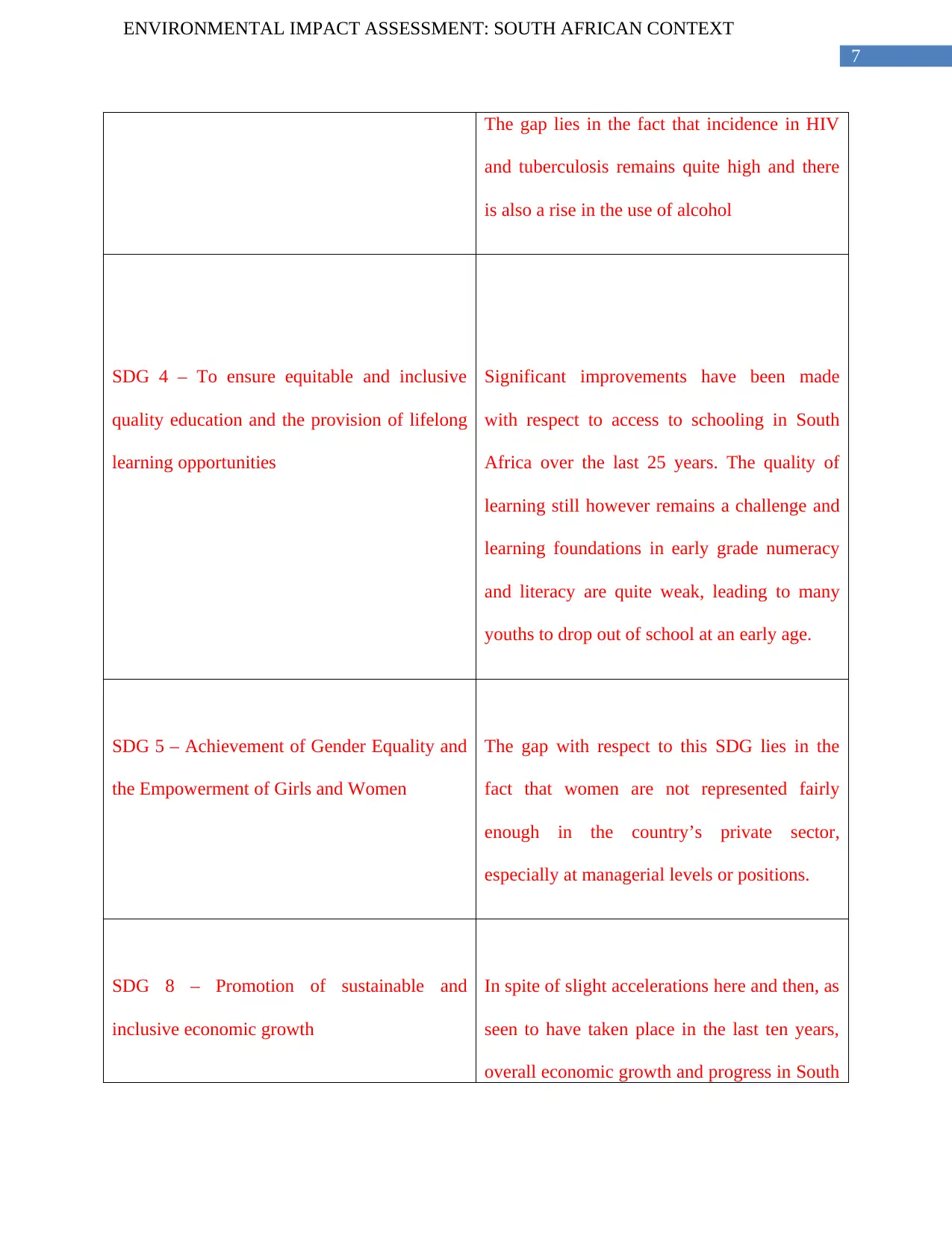
7
ENVIRONMENTAL IMPACT ASSESSMENT: SOUTH AFRICAN CONTEXT
The gap lies in the fact that incidence in HIV
and tuberculosis remains quite high and there
is also a rise in the use of alcohol
SDG 4 – To ensure equitable and inclusive
quality education and the provision of lifelong
learning opportunities
Significant improvements have been made
with respect to access to schooling in South
Africa over the last 25 years. The quality of
learning still however remains a challenge and
learning foundations in early grade numeracy
and literacy are quite weak, leading to many
youths to drop out of school at an early age.
SDG 5 – Achievement of Gender Equality and
the Empowerment of Girls and Women
The gap with respect to this SDG lies in the
fact that women are not represented fairly
enough in the country’s private sector,
especially at managerial levels or positions.
SDG 8 – Promotion of sustainable and
inclusive economic growth
In spite of slight accelerations here and then, as
seen to have taken place in the last ten years,
overall economic growth and progress in South
ENVIRONMENTAL IMPACT ASSESSMENT: SOUTH AFRICAN CONTEXT
The gap lies in the fact that incidence in HIV
and tuberculosis remains quite high and there
is also a rise in the use of alcohol
SDG 4 – To ensure equitable and inclusive
quality education and the provision of lifelong
learning opportunities
Significant improvements have been made
with respect to access to schooling in South
Africa over the last 25 years. The quality of
learning still however remains a challenge and
learning foundations in early grade numeracy
and literacy are quite weak, leading to many
youths to drop out of school at an early age.
SDG 5 – Achievement of Gender Equality and
the Empowerment of Girls and Women
The gap with respect to this SDG lies in the
fact that women are not represented fairly
enough in the country’s private sector,
especially at managerial levels or positions.
SDG 8 – Promotion of sustainable and
inclusive economic growth
In spite of slight accelerations here and then, as
seen to have taken place in the last ten years,
overall economic growth and progress in South
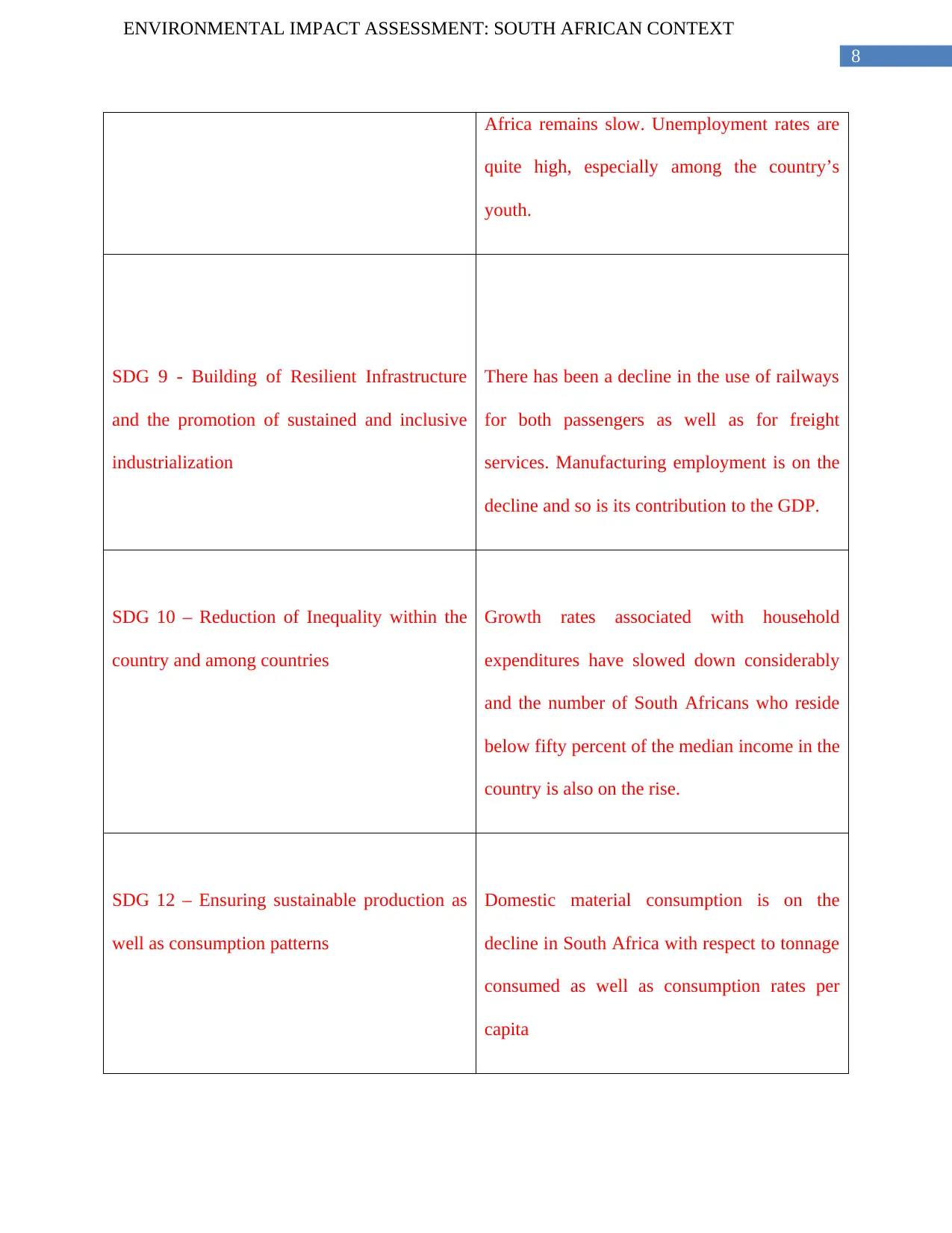
8
ENVIRONMENTAL IMPACT ASSESSMENT: SOUTH AFRICAN CONTEXT
Africa remains slow. Unemployment rates are
quite high, especially among the country’s
youth.
SDG 9 - Building of Resilient Infrastructure
and the promotion of sustained and inclusive
industrialization
There has been a decline in the use of railways
for both passengers as well as for freight
services. Manufacturing employment is on the
decline and so is its contribution to the GDP.
SDG 10 – Reduction of Inequality within the
country and among countries
Growth rates associated with household
expenditures have slowed down considerably
and the number of South Africans who reside
below fifty percent of the median income in the
country is also on the rise.
SDG 12 – Ensuring sustainable production as
well as consumption patterns
Domestic material consumption is on the
decline in South Africa with respect to tonnage
consumed as well as consumption rates per
capita
ENVIRONMENTAL IMPACT ASSESSMENT: SOUTH AFRICAN CONTEXT
Africa remains slow. Unemployment rates are
quite high, especially among the country’s
youth.
SDG 9 - Building of Resilient Infrastructure
and the promotion of sustained and inclusive
industrialization
There has been a decline in the use of railways
for both passengers as well as for freight
services. Manufacturing employment is on the
decline and so is its contribution to the GDP.
SDG 10 – Reduction of Inequality within the
country and among countries
Growth rates associated with household
expenditures have slowed down considerably
and the number of South Africans who reside
below fifty percent of the median income in the
country is also on the rise.
SDG 12 – Ensuring sustainable production as
well as consumption patterns
Domestic material consumption is on the
decline in South Africa with respect to tonnage
consumed as well as consumption rates per
capita
⊘ This is a preview!⊘
Do you want full access?
Subscribe today to unlock all pages.

Trusted by 1+ million students worldwide
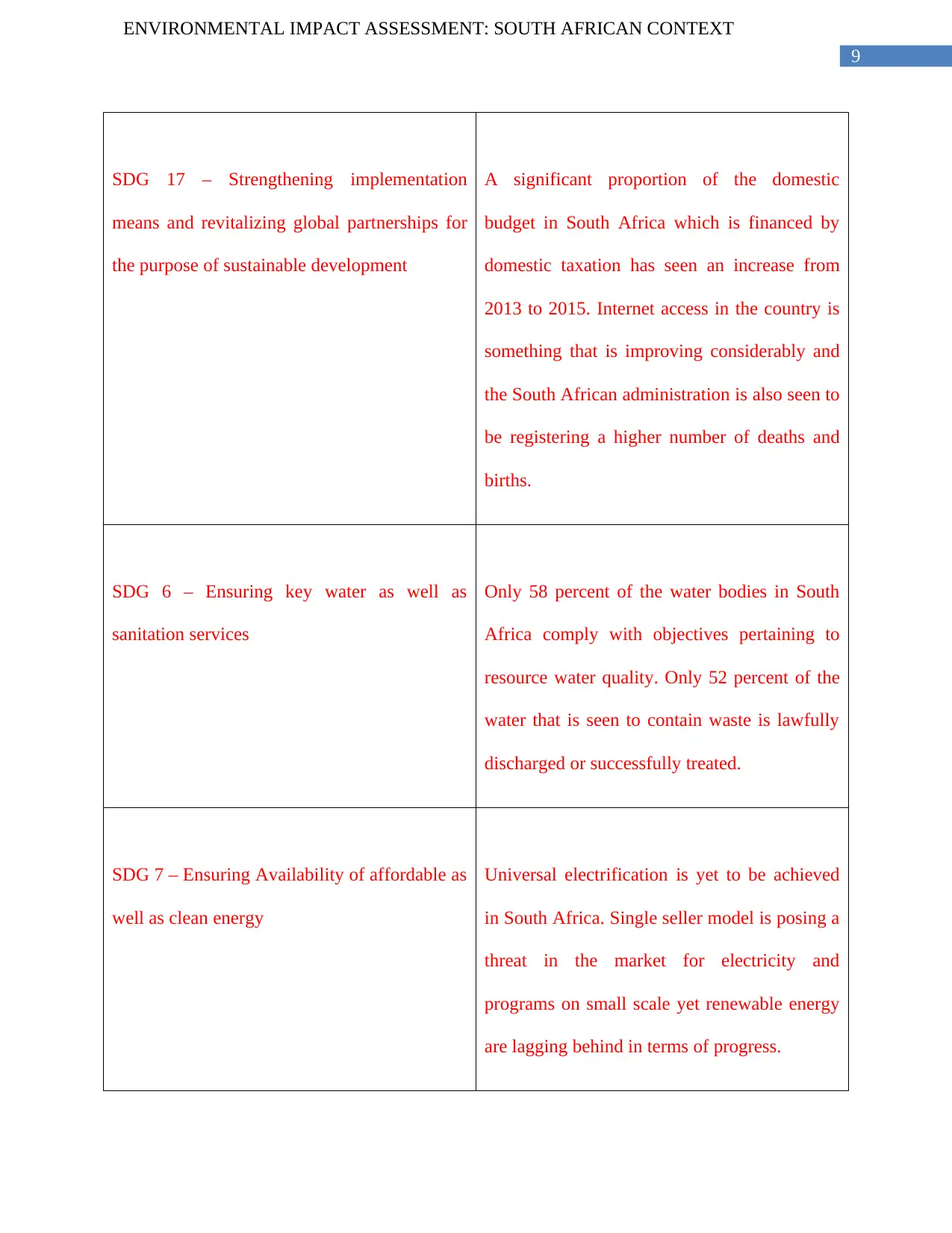
9
ENVIRONMENTAL IMPACT ASSESSMENT: SOUTH AFRICAN CONTEXT
SDG 17 – Strengthening implementation
means and revitalizing global partnerships for
the purpose of sustainable development
A significant proportion of the domestic
budget in South Africa which is financed by
domestic taxation has seen an increase from
2013 to 2015. Internet access in the country is
something that is improving considerably and
the South African administration is also seen to
be registering a higher number of deaths and
births.
SDG 6 – Ensuring key water as well as
sanitation services
Only 58 percent of the water bodies in South
Africa comply with objectives pertaining to
resource water quality. Only 52 percent of the
water that is seen to contain waste is lawfully
discharged or successfully treated.
SDG 7 – Ensuring Availability of affordable as
well as clean energy
Universal electrification is yet to be achieved
in South Africa. Single seller model is posing a
threat in the market for electricity and
programs on small scale yet renewable energy
are lagging behind in terms of progress.
ENVIRONMENTAL IMPACT ASSESSMENT: SOUTH AFRICAN CONTEXT
SDG 17 – Strengthening implementation
means and revitalizing global partnerships for
the purpose of sustainable development
A significant proportion of the domestic
budget in South Africa which is financed by
domestic taxation has seen an increase from
2013 to 2015. Internet access in the country is
something that is improving considerably and
the South African administration is also seen to
be registering a higher number of deaths and
births.
SDG 6 – Ensuring key water as well as
sanitation services
Only 58 percent of the water bodies in South
Africa comply with objectives pertaining to
resource water quality. Only 52 percent of the
water that is seen to contain waste is lawfully
discharged or successfully treated.
SDG 7 – Ensuring Availability of affordable as
well as clean energy
Universal electrification is yet to be achieved
in South Africa. Single seller model is posing a
threat in the market for electricity and
programs on small scale yet renewable energy
are lagging behind in terms of progress.
Paraphrase This Document
Need a fresh take? Get an instant paraphrase of this document with our AI Paraphraser
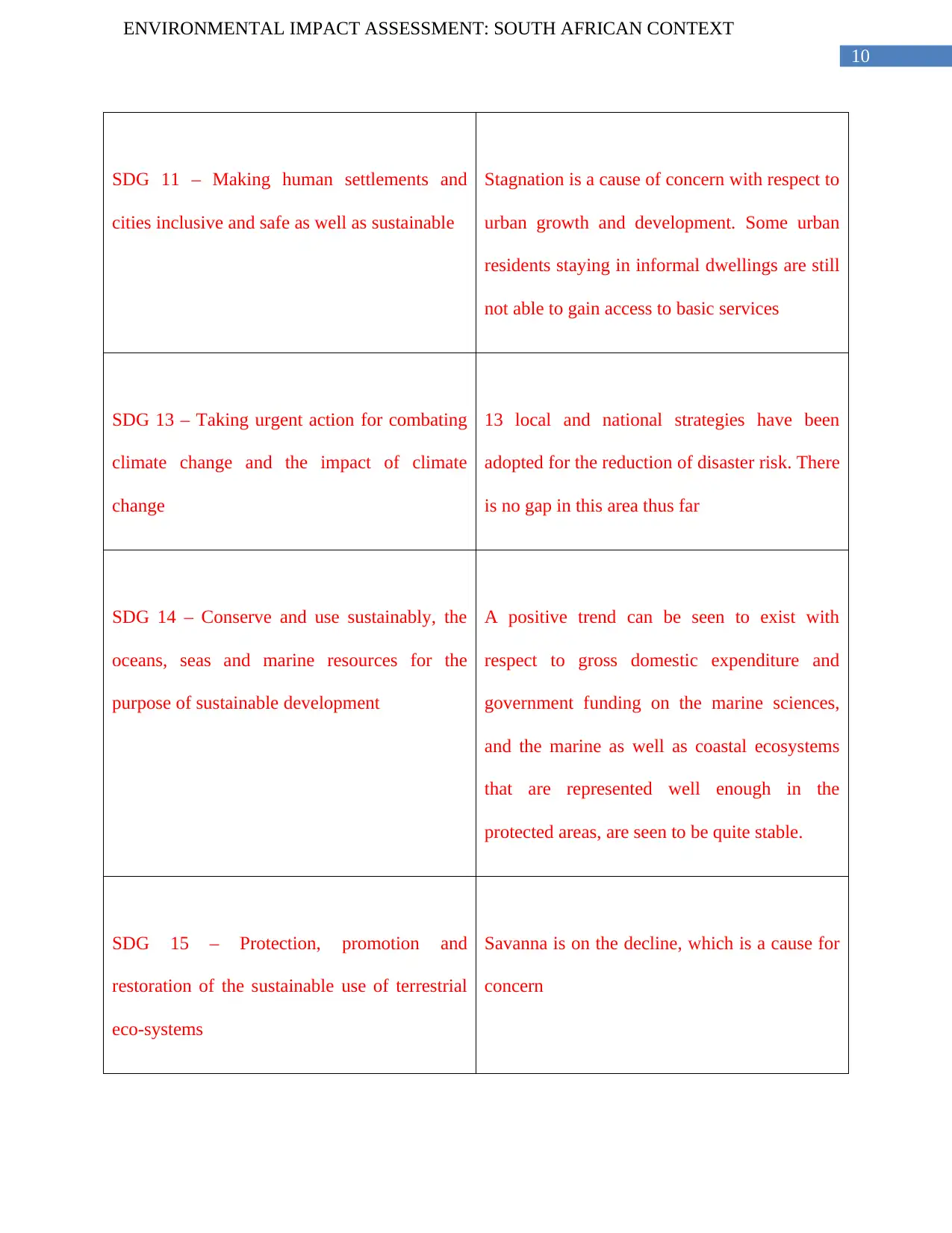
10
ENVIRONMENTAL IMPACT ASSESSMENT: SOUTH AFRICAN CONTEXT
SDG 11 – Making human settlements and
cities inclusive and safe as well as sustainable
Stagnation is a cause of concern with respect to
urban growth and development. Some urban
residents staying in informal dwellings are still
not able to gain access to basic services
SDG 13 – Taking urgent action for combating
climate change and the impact of climate
change
13 local and national strategies have been
adopted for the reduction of disaster risk. There
is no gap in this area thus far
SDG 14 – Conserve and use sustainably, the
oceans, seas and marine resources for the
purpose of sustainable development
A positive trend can be seen to exist with
respect to gross domestic expenditure and
government funding on the marine sciences,
and the marine as well as coastal ecosystems
that are represented well enough in the
protected areas, are seen to be quite stable.
SDG 15 – Protection, promotion and
restoration of the sustainable use of terrestrial
eco-systems
Savanna is on the decline, which is a cause for
concern
ENVIRONMENTAL IMPACT ASSESSMENT: SOUTH AFRICAN CONTEXT
SDG 11 – Making human settlements and
cities inclusive and safe as well as sustainable
Stagnation is a cause of concern with respect to
urban growth and development. Some urban
residents staying in informal dwellings are still
not able to gain access to basic services
SDG 13 – Taking urgent action for combating
climate change and the impact of climate
change
13 local and national strategies have been
adopted for the reduction of disaster risk. There
is no gap in this area thus far
SDG 14 – Conserve and use sustainably, the
oceans, seas and marine resources for the
purpose of sustainable development
A positive trend can be seen to exist with
respect to gross domestic expenditure and
government funding on the marine sciences,
and the marine as well as coastal ecosystems
that are represented well enough in the
protected areas, are seen to be quite stable.
SDG 15 – Protection, promotion and
restoration of the sustainable use of terrestrial
eco-systems
Savanna is on the decline, which is a cause for
concern
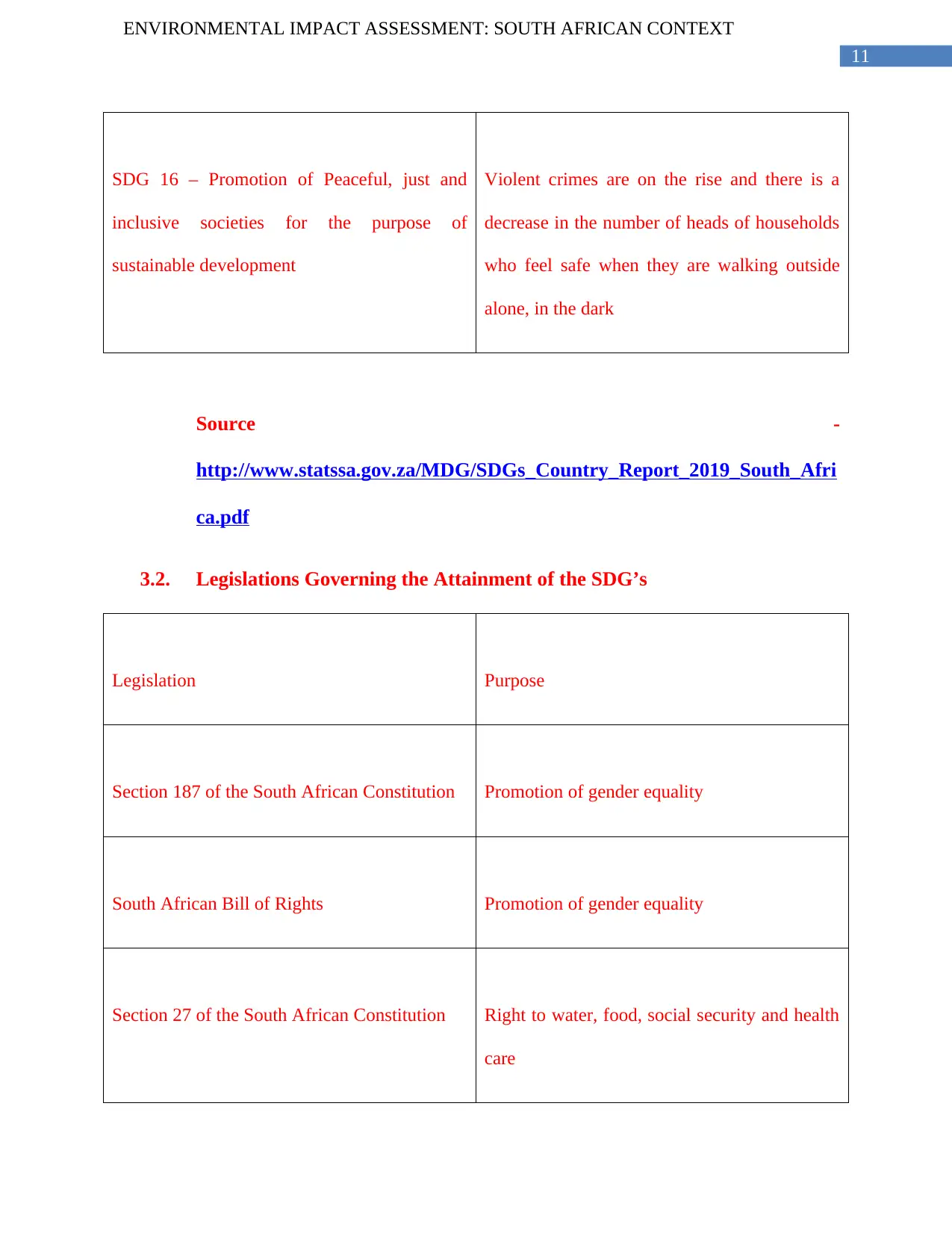
11
ENVIRONMENTAL IMPACT ASSESSMENT: SOUTH AFRICAN CONTEXT
SDG 16 – Promotion of Peaceful, just and
inclusive societies for the purpose of
sustainable development
Violent crimes are on the rise and there is a
decrease in the number of heads of households
who feel safe when they are walking outside
alone, in the dark
Source -
http://www.statssa.gov.za/MDG/SDGs_Country_Report_2019_South_Afri
ca.pdf
3.2. Legislations Governing the Attainment of the SDG’s
Legislation Purpose
Section 187 of the South African Constitution Promotion of gender equality
South African Bill of Rights Promotion of gender equality
Section 27 of the South African Constitution Right to water, food, social security and health
care
ENVIRONMENTAL IMPACT ASSESSMENT: SOUTH AFRICAN CONTEXT
SDG 16 – Promotion of Peaceful, just and
inclusive societies for the purpose of
sustainable development
Violent crimes are on the rise and there is a
decrease in the number of heads of households
who feel safe when they are walking outside
alone, in the dark
Source -
http://www.statssa.gov.za/MDG/SDGs_Country_Report_2019_South_Afri
ca.pdf
3.2. Legislations Governing the Attainment of the SDG’s
Legislation Purpose
Section 187 of the South African Constitution Promotion of gender equality
South African Bill of Rights Promotion of gender equality
Section 27 of the South African Constitution Right to water, food, social security and health
care
⊘ This is a preview!⊘
Do you want full access?
Subscribe today to unlock all pages.

Trusted by 1+ million students worldwide
1 out of 21
Related Documents
Your All-in-One AI-Powered Toolkit for Academic Success.
+13062052269
info@desklib.com
Available 24*7 on WhatsApp / Email
![[object Object]](/_next/static/media/star-bottom.7253800d.svg)
Unlock your academic potential
Copyright © 2020–2025 A2Z Services. All Rights Reserved. Developed and managed by ZUCOL.





